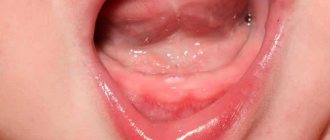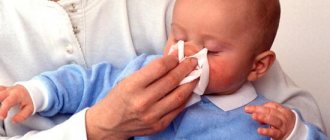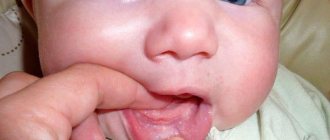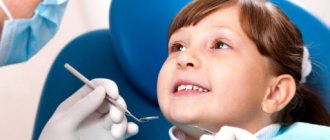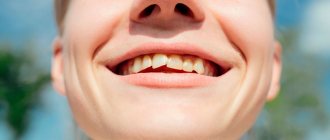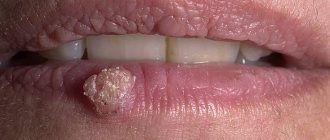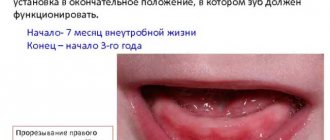20.11.2019
The eruption of baby teeth in a child is a gradual process, and it takes approximately 2-3 years until all 20 baby teeth erupt. Initially, when the first baby teeth erupt, children, as a rule, experience difficulties of various kinds. So, at the age of 3-9 months, children may increase salivation, they begin to bite and gnaw at everything, and they may experience shooting pain in the ears.
In this case, parents may assume that the child is actively teething. In addition, during this period children become extremely irritable and whiny. If you experience shooting pains in the ear, it is important to make sure that they are not associated with an infectious ear disease, since many of the symptoms of teething and ear infections are similar. While teething is a natural process and there are many ways to help your baby get through this difficult time, ear infections (ear infections) require special medical evaluation and treatment.
Teething and otitis media in babies
Parents should be able to clearly distinguish between the symptoms characteristic of teething and otitis media. While older children can tell what's bothering them, toddlers are not yet able to do so, so parents must be extremely careful as the symptoms are similar in the two cases of ear pain, and the causes (and therefore treatment) ) are different.
Inflammation of the middle ear (otitis) is a common disease in very young children. A child suffering from otitis may be very irritable and may refuse to eat. Meanwhile, the same thing often happens when his first teeth are cut.
What is the connection between the process of teething and shooting pains in the ear? Although such ear pain is typical for infectious diseases of the ear, the occurrence of pain during teething is due to the proximity of the ear and jaw muscles. Pain that occurs in the gum can radiate to the ear or cheek. Therefore, children may rub their cheek or ear, but in fact the cause of the pain is in the gum, at the site of tooth eruption. The child experiences discomfort in places other than where it really hurts.
However, although teething can mimic ear inflammation, there are some factors that can help differentiate ear infections from teething. For example, when teething, the child’s body temperature may increase only slightly, and high temperature is not typical for this process. When a baby is teething, he will not be capricious all the time, but only when the tooth is actively cutting. With an ear infection (otitis media), the child may cry inconsolably for a long time.
More often, middle ear inflammation occurs in children who have recently had a runny nose. Otitis occurs, as a rule, with the onset of cold weather (in the hot season, otitis is rare). In addition, characteristic signs of otitis media include fluid accumulation or swelling in the ear. You should consult a pediatrician or ENT doctor if you feel that your child has become less responsive to sounds.
An effective way to relieve teething problems for children
Summary. In some children, the eruption of primary teeth has a negative impact on their general condition. This physiological process often gives the child discomfort - pain, hyperemia of the mucous membrane, hypersalivation, burning, itching in the mouth, and an increase in general body temperature. Teething symptoms can be relieved at home. Dentists recommend the use of special gels and ointments that have not only an analgesic effect, but also antiseptic properties. The purpose of this work was to evaluate the effectiveness of using a gel based on Boswellia serrata resin extract, aloe vera leaf juice and chamomile flower extract during the eruption of primary teeth in children. The article discusses the issue of using the gel during the eruption of primary teeth in children. At the Department of Pediatric Dentistry and Orthodontics, Institute of Dentistry named after. E.V. Borovsky First Moscow State Medical University named after. I.M. Sechenov observed 67 children aged from 5 months to 3 years (the period of eruption of primary teeth). A special gel was prescribed as an auxiliary drug to relieve pain during teething. Based on the results of clinical changes in local and general symptoms associated with the eruption of primary teeth in 67 children, a significant reduction in symptoms was observed already on the 3rd day of using the gel in 30-50%, on the 5th day – in 50-80%, on the 7th – 90-100%. According to a survey of parents, the effectiveness of the gel used is 91% of respondents who used the gel during the eruption of primary teeth, which corresponded to a high level of effectiveness of the drug.
Teething in children is one of the common problems in both pediatrics and pediatric dentistry. This physiological process is closely related to the general condition of the child. Typically, pain symptoms appear 4 days before tooth eruption and decrease 3 days after tooth eruption [1]. During this period, in the gingival fluid during primary teething, the concentration of inflammatory cytokines - interleukins (IL-1, IL-2, IL-8) and tumor necrosis factors α (TNF-α) increases, which explains the clinical manifestations of both local and general nature associated with teething [2].
Thus, the eruption of primary teeth occurs at the age of 6 months and ends by 2.5-3 years, however, this period can begin at the 3rd month of a child’s life, depending on the individual characteristics of the structure and formation of tooth germs. In some cases, teething is not accompanied by any complaints or complications, either local or general [3]. However, in some children this physiological process has a negative impact on their general condition. Irritability, biting of hands, lips or objects, restlessness and tearfulness have been found to be associated with teething, and there is often a sudden increase in the incidence of respiratory infections, middle ear infections, and specific infections such as herpetic gingivostomatitis and herpetic infections [4]. .
Teething is preceded by inflammation of the gums in the corresponding area with the formation of hyperemia and edema [3-4]. The period of eruption of one tooth lasts on average from 3 to 8 days, followed by the appearance of the crown part of the tooth.
This physiological process often gives the child such unpleasant sensations as pain, burning and itching in the oral cavity, accompanied by hyperemia of the mucous membrane, hypersalivation, and an increase in general body temperature [5].
Often, the symptoms of some common somatic diseases are perceived by parents and doctors as teething syndrome, which entails a number of complications and consequences. This is primarily due to the low level of awareness of pediatricians about the manifestations of common somatic diseases, as well as insufficiently complete collection of anamnestic data analysis. It is important to understand that at the time of teething, in addition to local manifestations in the oral cavity, a violation of the child’s general condition occurs, which is also possible with various infectious diseases. That is why it is especially important to conduct a thorough differential diagnosis in children to exclude infectious and inflammatory diseases.
In addition, for correct diagnosis and identification of symptoms, it is necessary to remember the timing of the eruption of primary teeth. Thus, the eruption of the first teeth - the central incisors of the lower jaw - occurs at 4-6 months, the central incisors of the upper jaw - at 5-7 months, and by the age of two years a child should normally have 20 temporary teeth.
It should also be understood that the appearance of primary teeth is an important stage in a child’s life, since from this moment on he can eat more solid foods. Along with this, the formation and development of dental arches occurs, which is directly related to the development of the maxillofacial system as a whole.
That is why it is especially important to pay due attention to the period of teething, as well as the symptoms accompanying this physiological process.
At the time of primary teeth eruption, in addition to pain in the child, hyperemia and swelling of the gums, copious amounts of saliva are produced, which can lead to skin irritation and the development of perioral dermatitis. Also, some children may have a deterioration in appetite, which can lead to disorders of the gastrointestinal tract (GIT) and weight loss. In rare cases, this also leads to dyspeptic disorders. Teething is often accompanied by sleep disturbances in the child, irritability, lethargy, drowsiness and crying. All these symptoms lead to the fact that not only the child becomes irritable and restless, but also the parents experience nervous tension [6].
In turn, some teething symptoms can be relieved at home with the help of special aids such as teething rings and toys filled with coolant. In addition, dentists recommend the use of special gels and ointments that have not only an analgesic effect, but also antiseptic properties [7, 8].
In this regard, the issue of using auxiliary local medications in the oral cavity in order to reduce both local and general pain in a child is becoming increasingly relevant.
Materials and research methods
At the Department of Pediatric Dentistry and Orthodontics, Institute of Dentistry named after. E.V. Borovsky First Moscow State Medical University named after. I.M. Sechenov observed 67 children aged from 5 months to 3 years (the period of eruption of primary teeth).
Dentinale® natura gel was prescribed as an auxiliary drug to relieve pain during teething in order to evaluate the effectiveness of its use. The main active ingredients of this drug are boswellia serrata resin extract, aloe vera leaf juice, chamomile flower extract. Boswellia extract has an analgesic effect, aloe vera juice has an antiseptic effect, chamomile extract soothes and promotes healing of irritated oral mucosa. It should be noted that this drug does not contain lidocaine (which can cause allergic reactions), as well as sugar and parabens.
The use of this drug was recommended according to the following scheme: squeeze a small amount of gel onto the tip of a clean finger and apply with massaging movements to the child’s gums, apply 3-5 times a day. For 20-30 minutes after applying the gel, refrain from eating or drinking to avoid premature removal of the gel from the gums.
Dentinale® natura gel forms a protective film on inflamed gums, reduces sensitivity, irritation and inflammation of the gums, helping the child cope with teething more easily without resorting to analgesics and anesthetics.
The effectiveness of using Dentinale® natura gel during teething was assessed on the 1st, 3rd and 7th day of use. Local symptoms of damage to the alveolar mucosa (hyperemia, swelling, bleeding, submucosal hematomas, hemorrhages), the presence of general symptoms of intoxication of the child’s body (increased body temperature, anxiety with sleep and appetite disturbances, hypersalivation, digestive disorders) were taken into account. To evaluate these eruption symptoms, they were divided according to the severity of the manifestations (mild changes, moderate and severe). At the end of the observation period, parents were asked to fill out a questionnaire to subjectively assess the criteria for the effectiveness of the gel during teething in children and satisfaction with the use of the product. Parents assessed the ease of use, the effect on the child’s behavior (anxiety), the effect on the oral mucosa, the organoleptic properties of the gel and gave a general assessment by answering the questions: “yes” - 1 point, “no” - 0 points.
results
During the treatment and observation of 67 children with difficult eruption of primary teeth, it was revealed that mild changes in the alveolar mucosa were in 31% (n = 21), moderate manifestations - in 57% (n = 38), severe - in 12% (n = 8).
Treated with symptoms:
- swelling and redness of the gums – n = 67 (100%);
- decreased appetite – n = 64 (96.4%);
- indigestion – n = 31 (46.67%);
- increased temperature – n = 59 (88%);
- irritability and tearfulness – n = 63 (94.34%);
- increased salivation – n = 67 (100%);
- restless sleep – n = 63 (94.34%).
In general, during the medical examination, there was a positive trend in all symptoms (Table).
In children with mild changes in the mucous alveolar part of the gums during teething, a decrease in local symptoms was noted on the 3rd day of using Dentinale® natura gel in 48-62% of cases, on the 5th day - in 86-90.5%, on 7- On the 1st day, symptoms were practically absent. General symptoms decreased on the 3rd day by 56-70%, on the 5th day - by 86-90.5%, and on the 7th they were practically absent.
In children with moderate changes in the mucous membrane of the alveolar part of the gums during teething, there was a decrease in local symptoms on the 3rd day of using the gel by 35-53%, on the 5th day - by 76-87%, on the 7th day - by 96% . General symptoms decreased on the 3rd day by 27-60%, on the 5th day - by 90.1%, and on the 7th they were practically absent.
In children with moderate changes in the mucous membrane of the alveolar part of the gums during teething, a decrease in local symptoms was noted on the 3rd day of using the gel; local symptoms on the 3rd day of using the gel decreased by 10-50%, on the 5th day - by 50-75 %, on the 7th day – by 75-100%. General symptoms decreased on the 3rd day by 50%, on the 5th day - by 75%, on the 7th - by 75-100%.
The most pronounced was increased salivation throughout the 7-day observation, swelling and sharp hyperemia of the gums, fever, sleep disturbances and appetite were completely relieved, other symptoms had minimal manifestations by the 7th day of observation (Table).
According to the study, there were no undesirable reactions, including allergic reactions, when using the gel.
We have also observed that the gentle effect of Dentinale® natura gel on the oral mucosa, instant cooling and pain relief allow parents to perform this procedure frequently and for a long time. We assume that therefore it is not difficult for parents to use the gel 3-5 times a day using finger massage and rubbing it in for 20-30 seconds, which in turn significantly speeds up teething and thereby quickly eliminates the negative symptoms associated with this process .
After use, a parent survey was conducted, with the help of which we obtained an assessment of the use of the gel and the characteristics of the drug used. Questionnaires were generated in which the main questions were devoted to the relevant topic and were scored.
Questions about efficiency:
- Has a sedative effect (yes/no).
- Quickly relieves pain (yes/no).
- When applied, it does not cause additional irritation to the mucous membrane (yes/no).
- After application, the child does not try to spit out the gel (yes/no).
- Active relief of the inflammatory symptom of the mucous membrane occurs when using the gel after 3 days (yes/no).
Questions about the properties of the drug:
The positive characteristics of Dentinale® natura are that the product:
- Without lidocaine (yes/no).
- No sugar (yes/no).
- Paraben free (yes/no).
- Has a pleasant taste for a child (yes/no).
- When applied, it forms a protective film on inflamed gums (yes/no).
- Harmless if swallowed (yes/no).
- Has no age restrictions (yes/no).
Based on the results of the survey, the following interpretation of the sums of assessment points was established for children with difficulty teething: “yes” – 1, “no” – 0.
Points from 0.8 to 1 – high level of effectiveness of the gel. Scores from 0.5 to 0.8 are a good level. Points from 0.2 to 0.5 – satisfactory. Scores from 0 to 0.2 – low.
When analyzing the questionnaires completed by parents, a trend was identified for a rapid decrease in symptoms of gum inflammation (5 ± 2.5 days).
Of 67 parents, 91% of respondents whose children used Dentinale® natura gel during the eruption of primary teeth scored an overall assessment of the use of the product with an average score of 0.8-1, which corresponded to a high level of effectiveness of the drug.
An average score of 0.5-0.8 was scored by 8.08% of children, which corresponded to a good level of effectiveness of the gel.
An average score of 0.2-0.5 was scored by 0.92% of children, which corresponded to a satisfactory level of effectiveness of application.
No one scored an average score of 0-0.2.
All observation participants noted the good tolerability of the product (there were no adverse reactions), its pleasant organoleptic characteristics and immediate effect, as well as from the words of parents: “The child almost immediately after application forgets about bothering teeth and starts playing merrily...”
Clinical example: child 8 months old, difficult teething 5.1, 6.1.
Complaints of swelling and redness of the gums, decreased appetite n = 64 (96.4%), increased temperature, especially in the evening up to 38? C, irritability and tearfulness, increased salivation, restless sleep.
Objectively: in the area of the projection of teeth 5.1, 6.1 - sharp hyperemia of the gums with pronounced swelling and sharp pain on palpation, increased salivation, the child is anxious and tearful.
Conclusion. K00.7 Eruption syndrome.
Clinically: moderate disruption of the gingival mucosa in the area of eruption.
Recommended topically: use of Dentinale® natura gel. Squeeze a small amount of gel onto the tip of a clean finger and apply with massaging movements to the child’s gums, apply 3-5 times a day. For 20-30 minutes after applying the gel, refrain from feeding the child and do not give him liquid in order to avoid premature removal of the gel from the gums.
Clinical evaluation of the use of the gel: there was no swelling of the gums on the 3rd day of use, on the 4th day the appearance of the edge of tooth 5.1 was observed, pain on palpation and hyperemia of the gums on the 5th day, the appearance of the edge of tooth 6.1, restoration of appetite on the 5th day , normalization of temperature - on the 3rd day, a significant decrease in salivation and normal sleep - on the 5th day.
Result: the assessment of the effectiveness of the gel according to the parent questionnaire was 1 point, which corresponded to a high level of effectiveness of the drug.
Discussion
On the modern market of various pharmaceutical companies there is a wide variety of products that can reduce the pain sensitivity of the oral mucosa and stimulate painless teething [9]. However, most of the drugs on the market contain an analgesic or anesthetic as the main component, the use of which has a high risk of adverse reactions. A scientific study found that over-the-counter use of benzocaine anesthetics in the form of gels and liquids in the oral cavity in children under 2 years of age can lead to serious complications [10]. The American Food and Drug Administration (FDA) has found that the use of benzocaine can lead to methemoglobinemia, manifested by pale and bluish skin of the lips and nail beds, shortness of breath, rapid heartbeat, and confusion [10].
Elizabeth Super (2021) recommends the use of Tylenol children's gel to reduce gum pain [11]. It is worth noting that Tylenol gel is widely used in pediatric dental practice, however, the American Academy of Pediatricians states that this gel has significant side effects, manifested by numbness of the oropharynx and, as a result, difficulty swallowing [11].
In turn, we recommend the use of Dentinale® natura gel, since its analgesic effect is achieved through boswellia extract, which is safe when swallowed and does not cause side effects such as numbness of the oropharynx and confusion. Boswellia has unique medicinal properties that have been known for a very long time and are successfully used in the treatment of many diseases. First of all, these are anti-inflammatory properties: boswellic acids act in such a way that the synthesis of leukotrienes is blocked, resulting in an effect similar to non-steroidal anti-inflammatory drugs, but without side effects.
M.D. Velikoretskaya (2017) in her study divides teething gels into 4 groups:
- with an anesthetic effect based on an anesthetic;
- based on anti-inflammatory or antiseptic agents;
- on a homeopathic basis;
- based on extracts of medicinal plants [12].
Having analyzed each group of drugs, the author found that the use of a gel based on plant extracts allows not only to facilitate teething in children of the first and second year of life, but also to avoid unwanted complications that are possible when using drugs containing chemical anesthetics and anti-inflammatory substances [12, 13].
Based on the results of the study, Dentinale® natura gel, the main active ingredients of which are boswellia extract, which has an analgesic effect, aloe vera juice, which has an antiseptic effect, and chamomile extract, which has anti-inflammatory and wound healing effects, is the most effective and safe remedy for children of this age group.
There is also Ashton and Parsons baby powder, the active ingredient of which is a tincture of matricaria with the addition of chamomile. It should be noted that this drug has a sedative effect, relieves tension, anxiety and irritability, without having an anesthetic effect [14-16].
Preparations with lidocaine and sugar adversely affect the general condition of the child, causing serious side effects. The main disadvantage of these drugs is hypersensitivity to lidocaine with the subsequent development of an allergic reaction in the form of localized swelling, accompanied by minor difficulty breathing or a generalized rash.
It should be noted that Dentinale® natura gel does not contain lidocaine, sugar and parabens, since the base is made of plant components. The ability of the gel to have an anti-inflammatory, antiseptic and wound-healing effect is also due to the formation of a protective film on the inflamed gums, which reduces sensitivity, irritation and inflammation of the gums, helping the child to more easily endure the period of teething, without resorting to analgesic and anesthetic drugs.
conclusions
Thus, based on the results of clinical changes in local and general symptoms associated with the eruption of primary teeth in 67 children using Dentinale® natura gel, already on the 3rd day a significant reduction in symptoms was observed in 30-50%, on the 5th day – in 50-80%, on the 7th – in 90-100% of infants.
According to a survey of parents, the effectiveness of the Dentinale® natura gel is 91% of respondents who used it during the eruption of primary teeth, which corresponded to a high level of effectiveness of the drug, since the use of a plant-based gel not only facilitates the process of teething, but also avoids complications which occur when using products containing anesthetics, analgesics and anti-inflammatory drugs.
One of the main advantages of the drug is its antiseptic, wound-healing and safe effect on painful teething in children.
CONFLICT OF INTEREST. The authors of the article have confirmed that there is no conflict of interest to disclose.
CONFLICT OF INTERESTS. Not declared.
Literature/References
- Kazyukova T.V., Radtsig E.Yu., Pankratov I.V. Symptoms of the eruption of primary teeth and possible ways of pharmacological action // RMJ. 2015; 22: 1342-1344.
- Zaplatnikov A.L., Kasyanova A.N., Maykova I.D. Teething syndrome in infants: a new look at an old problem // RMJ. 2018; 5 (II): 68-71.
- Diouf M., Dieng A., Boëtsch G., Cisse D. Mothers' responses to teething in children in Ferlo, Senegal // Sante Publique. 2018; 30 (3): 405-410.
- Michael Sarrell EM, Horev Z., Cohen Z., Cohen HA Parents' and medical personnel's beliefs about teeth infanting // Patient Education and Counseling. 2005; 57 (1): 122-125.
- Vaysse F., Noirrit E., Bailleul-Forestier I., Bah A., Bandon D. Eruption and teething complications // Archives de Pediatrie. 2010; 17 (6): 756-757.
- Plutzer K., Spencer AJ, Keirse MJ How first-time mothers perceive and deal with teething symptoms: a randomized controlled trial // Child Care Health Dev. 2012; 38 (2): 292-299.
- Baykan Z., Sahin F., Beyazova U., Ozcakar B., Baykan A. Experience of Turkish parents about their infants' teething // Child Care Health Dev. 2004; 30 (4): 331-336.
- Jones M. Teething in children and the alleviation of symptoms // J Fam Health Care. 2002; 12 (1): 12-13.
- Wilson PH, Mason C. The trouble with teething? misdiagnosis and misuse of a topical medicament // Int J Paediatr Dent. 2002; 12 (3): 215-218.
- Murkoff H. Are Teething Gels Safe? What to Expect When You're Expecting. 2022. https://www.whattoexpect.com/first-year/ask-heidi/are-teething-gels-safe.aspx.
- The Straight Scoop on Teething and Sleep // KinderCare. 2022. https://www.kindercare.com/content-hub/articles/2017/february/the-straight-scoop-on-teething-and-sleep.
- Velikoretskaya M.D., Starostina L.S. Safe and effective assistance in the eruption of primary teeth // RMZh. 2017; 19: 1341-1345.
- Lukashevich M. G. The place of drugs based on plant extracts in alleviating the symptoms of painful teething // RMZh. 2016; 18: 1232-1234.
- McIntyre G., McIntyre G. Teething troubles? // Br Dent J. 2002; 251-255.
- Serban R., Dionisio F., Filippo M., Mihai G. New medical device coating mouth gel for temporary relief of teething symptoms: a pilot randomized, open-label, controlled study // Edizioniminervamedica. 2018; 23-25.
- Siddiqui MZ, Serrata B. A Potential Antiinflammatory Agent: An Overview // Indian J Pharm Sci. 2011; 73 (3): 255-261.
A. A. Mamedov1, Doctor of Medical Sciences, Professor A. A. Skakodub, Candidate of Medical Sciences O. V. Dudnik, Candidate of Medical Sciences A. S. Chertikhina A. R. Beznosik
Federal State Autonomous Educational Institution of Higher Education First Moscow State Medical University named after. I. M. Sechenov Ministry of Health of Russia, Moscow, Russia
1Contact information
An effective way to alleviate the condition of children during teething / A. A. Mamedov, A. A. Skakodub, O. V. Dudnik, A. S. Chertikhina, A. R. Beznosik For citation: Mamedov A. A., Skakodub A. A., Dudnik O.V., Chertikhina A.S., Beznosik A.R. An effective way to alleviate the condition of children during teething // Attending Doctor. 2021; vol. 24 (9): 16-20. DOI: 10.51793/OS.2021.24.9.003 Tags: children, baby teeth, temporary teeth, pain relief
Measures taken during teething and treatment of otitis media
Teething in children is a natural process that causes discomfort to the child, but is amenable to measures that do not require serious drug treatment. You can, for example, lightly massage your child's gums to soothe irritation. You can lubricate your gums with clove oil or vanilla extract. Teething rings or chilled foods are used that can be given to the child to chew on. It is important that the object that enters the child’s mouth is very clean so as not to cause infection. If these measures don't help, you can give your child a pain reliever.
If the child has a very high temperature and there are other symptoms of otitis media, it is necessary to consult a pediatrician or pediatric ENT doctor. Mild forms of otitis can be managed without medication, while serious forms will require antibiotic therapy (although pediatricians are generally not inclined to prescribe antibiotics for children under 6 months). Applying warm compresses to the sore ear may also help. Since the precursors of otitis media are usually the flu, runny nose or allergies, make sure that all measures are taken to prevent the development of these diseases.
Category Children Published by Mister stomatolog

